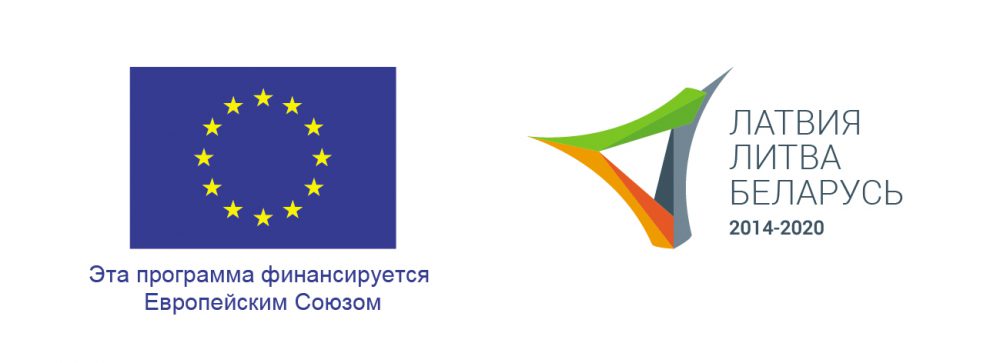
Прейльский музей истории и прикладного искусства (Латвия), Гродненский государственный музей истории религии (Беларусь) и Паневежский краеведческий музей (Литва) в рамках проекта «Продвижение исторического и культурного наследия на пограничье посредством внедрения инноваций в музеях» (ENI-LLB-1-244) программы трансграничного сотрудничества Латвия-Литва-Беларусь 2014-2020 представляют совместную виртуальную выставку «Рушники».
Прейльский музей истории и прикладного искусства
В коллекции Прейльского музея истории и прикладного искусства 82 традиционных полотенца (рушника), которые хронологически охватывают период с 1890 до 1986 г. Самый старый рушник был изготовлен около 1890 года в селе Русецки Лудзенского уезда. Последние рушники изготовлены в 1986 году в Ливанах сотрудниками Студии народного прикладного искусства «Дубна».
По функциональному назначению бывают почетные (праздничные, праздничные и гостевые рушники), повседневные (салфетки для рта и рук) и кухонные рушники. Рушники были неотъемлемой частью приданого невесты, их ткали, вышивали и украшали по-разному, чтобы доказать прекрасные способности и хороший вкус мастеров. Рушники, украшенные цветочными композициями в стиле модерн, наиболее широко представлены в коллекции музея.
Одно из самых популярных украшений концов рушников в музейной коллекции – кружево, связанное крючком. Вышивка также широко используется для украшения рушников. Их создавали жительницы региона, следуя тенденциям моды той эпохи. Концы рушника были украшены цветочными композициями с добавлением текста, вензелями, мотивами зарубежного фольклора. Особенно роскошны и изысканны рушники, декорированные в технике вытягивания (ажурная работа).
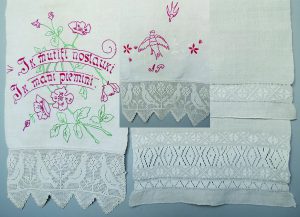
Самое старое полотенце соткано в 1890-х годах в селе Rusecki при помощи узорной трехкомпонентной конечной техники. Второе по возрасту полотенце конца ХІХ века. Полотенце сплетено трехконечным узором из льна, на концах — хлопковое кружево со стилизованным узором в виде птицы. Один конец полотенца расшит красными цветочками с зелеными листочками и надписью красным цветом «Протри свой рот и вспомни обо мне». На другом конце – вышивка двух птиц красным цветом, цветочный мотив, под ним монограмма AP красного цвета.
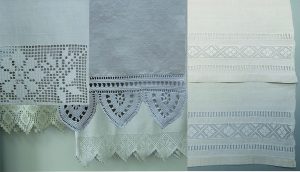
Особенно хороши белые рушники, изготовленные ткачихой Элеонорой Реча из Бабри, Силаянской волости, Резекненского уезда, в 1930-1940-х годах. Концы рушников декорированы как кружевами, так и ажурной работой с полосками, цветочными мотивами.
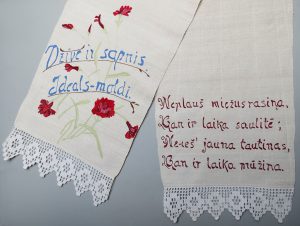
С начала ХХ в. появляются полотенца с вышитым текстом – пожеланиями, народными песнями, патриотическими стихами. Приобрести узоры для вышивки можно было в ремесленных мастерских. Рушник для рук Валентины Вайводе созданный в 1960-х гг. выделяется особенно богатой вышивкой. Один конец рушника украшен стилизованным цветком красного цвета, мотивом зеленого листа и надписью синего цвета «Жизнь – это мечта. Идеально — невозможно». Короткий текст народной песни вышит темно-красным цветом на другом конце рушника.
Гродненский государственный музей истории религии
Белорусский рушник (обрядовое вышитое полотенце) — верный спутник человека, который сопровождал его на протяжении всей жизни в течение многих веков. Он открыл целый мир образов, событий, верований и судеб многих поколений белорусов. Повитуха принимала ребенка рушником, рушники снимали при вступлении в брак, и молодожены стояли на рушнике в церкви. Рушники использовались, чтобы выносить мертвых из дома, затем приносить мертвых на кладбище и помещать его/ее в могилу. К тому же рушник сопровождал человека в повседневных делах с утра до позднего вечера. Поэтому рушник — одно из самых интересных явлений традиционной белорусской культуры. В коллекции Гродненского государственного музея истории религии имеется большое количество этнографических рушников разного типа. Давайте узнаем о них подробнее.
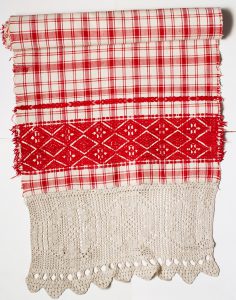
Рушник-набожник был наделен высшим статусом, так как издревле предназначался для украшения икон. В связи с этим его орнаментировали не только по краям, но и посередине.
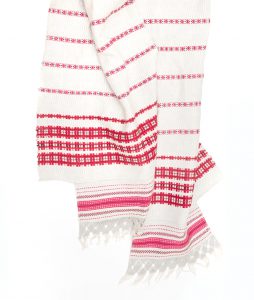
Рушник играл важную роль на свадьбах. В старину девушка на выданье вместе со старшими женщинами в семье вышивала не менее 30 рушников специально для свадьбы. Важные участники торжества — мать жениха, мать невесты, сваты были связаны рушниками. Во время свадьбы молодожены стояли на рушнике. Все эти обряды символизировали объединение двух семей. Некоторые обряды сохранились до наших дней.
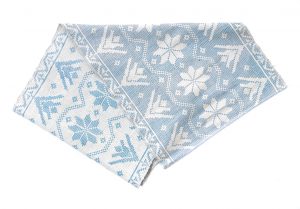
В погребальных обрядах рушник символизировал дорогу в мир иной. В деревнях было принято вывешивать рушник, когда кто-то умирал в доме. Еще до похорон и через шесть недель после них в доме висел рушник. Считалось, что душа умершего может найти убежище под рушником, возвращаясь домой.
Паневежский краеведческий музей
До середины ХХ в., в Литве преобладали домашние тканые рушники. Это узкая длинная салфетка для вытирания рук, лица и тела. Но с древних времен рушники использовались в семейных или общественных церемониях. Они были использованы в качестве подарка для свадьбы, крещения. Также их дарили могильщикам или гробовщикам. Раньше рушники использовали для принесения в жертву крестов или для оставления в священных местах.
Старые рушники с конца ХІХ до начала ХХ века ткались шириной 25 см и длиной 250-300 см. Узоры обычно представляли собой геометрические формы: квадраты, столбцы, полосы, круги. В конце каждого узора была выткана красная хлопчатобумажная нить. Для украшения концов полотенец использовались завязанные кисточки, кружево и трикотаж .
Коллекция этнографии Паневежиского краеведческого музея содержит в основном домашние тканные рушники 1930-1940 гг. В то время ткались более короткие и широкие (шириной 35-40 см) полотенца. Техники ткачества были улучшены и стали более сложными. Концы рушников обычно отделывались хлопчатобумажным трикотажем ручной работы и плетеными кисточками. Самые тонкие и красивые рушники украшали вышитые монограммы ткача (первые буквы имени и фамилии). Такие декоративные полотенца вешали в самом почетном месте дома или гостиной в качестве украшения.
Домашние полотенца середины ХХ века утратили свое прямое предназначение, но приобрели значение выражения литовской национальной идентичности. Они ткались по выборочным узорам, были намного шире прежних и приобрели декоративное значение. В узоре декоративных полотенец преобладает выборочный растительный орнамент. Также выбирались символы, важные для народа Литвы.
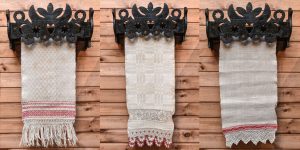
Эти рушники раскрывают этническое наследие северо-западной Аукштайтии.
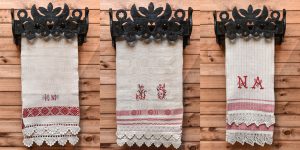
Такие рушники обычно вешали в самом почетном месте дома или гостиной. Их использовали в качестве подарка на свадьбу, крещение.
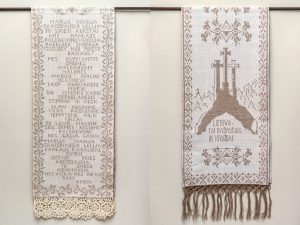
Они были подарены Юозапасу Антанавичусу ткачами на именины или в качестве пожертвования церкви перед Рождеством. Эти рушники поражают не только разнообразием рисунков, но и переплетенными символами или целыми текстами.
О проекте ENI-LLB-1-244 «Продвижение исторического и культурного наследия на пограничье посредством внедрения инноваций в музеях»
Проект направлен на создание платформы приграничного сотрудничества, создающей предпосылки для обеспечения растущего интереса туристов и посетителей к культурному и историческому наследию в приграничных районах Латвии, Литвы и Беларуси.
Этот проект финансируется Европейским Союзом.
Бюджет проекта: 367 864,64 евро, из них финансирование ЕС 331 078,17 евро, что составляет 865 111,50 белорусских рублей
Срок реализации проекта: 1 июня 2020 г. – 31 мая 2022 г.
Программа трансграничного сотрудничества Латвия-Литва-Беларусь 2014-2020 в рамках Европейского инструмента соседства
